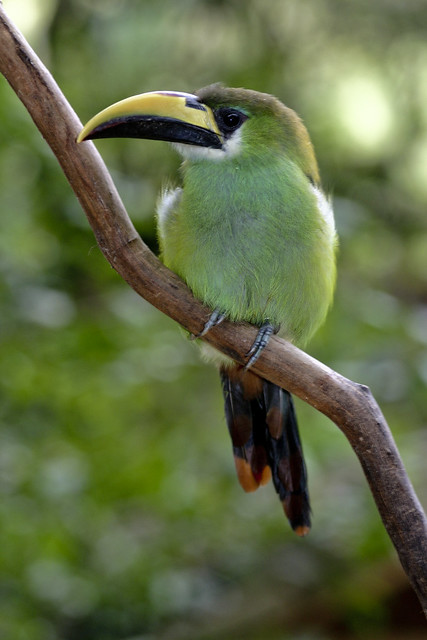(Original Title: Rainforest Birds - Emerald Toucanet)
 |
| Photo by brian.gratwicke |
Emerald Toucanet
Latin Name:
Aulacorhynchus prasinus
Status:
Least Concern
Scientific Classification:
Kingdom: Animalia
Phylum: Chordata
Class: Aves
Order: Piciformes
Family: Ramphastidae
Genus: Aulacorhynchus
Species: A. prasinus
General Information:
The Emerald Toucanet is the most widely distributed of all toucans, spanning from Mexico down as far south as Bolivia. Considered one of seven "mountain toucanets," this bird has fourteen subspecies existing throughout its range. It prefers to be in pairs or small flocks.
Physical Description:
When this bird reaches adult is usually 12 - 14 inches in length and weighs around 180 g. The male and female are similar in appearance, but the female is a little smaller with a slightly shorter bill. Both male and female are mostly green, like other members of its genus Aulachorhynchus. The Emerald Toucanet's bill is black with yellow on the upper mandible. There is also a small patch of white, blue, pale grey-blue, blue, or black on the throat, with the color depending on the subspecies.
Diet:
It feeds primarily on fruits, but will also eat bird eggs, insects, lizards, and other small prey.
Habitat:
This toucan occurs in humid forests, lowlands, as well as mountainous landscapes ranging from portions of Mexico through Central America, to northern Venezuela and south along the Andes to central Bolivia. The Emerald Toucanet often nests in an unlined hole in a tree, usually an old woodpecker's nest or sometimes a natural cavity.
Reproduction:
The female Emerald Toucanet lays three to four eggs per clutch, and both the male and the female incubate the eggs for a period of 14 to 15 days. The hatchlings are fed by both parents and fledge the nest after about 6 weeks.
By Tony Mandarich - Article Source: EzineArticles |

No comments:
Post a Comment